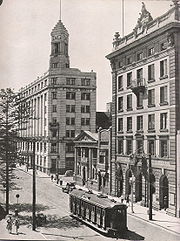
Dangar Grid
Encyclopedia

Newcastle, New South Wales
The Newcastle metropolitan area is the second most populated area in the Australian state of New South Wales and includes most of the Newcastle and Lake Macquarie Local Government Areas...
, Australia
Australia
Australia , officially the Commonwealth of Australia, is a country in the Southern Hemisphere comprising the mainland of the Australian continent, the island of Tasmania, and numerous smaller islands in the Indian and Pacific Oceans. It is the world's sixth-largest country by total area...
. Named after its designer, Henry Dangar
Henry Dangar
Henry Dangar was a surveyor and explorer of Australia in the early period of British colonisation. He became a successful pastoralist and businessman, and also served as a magistrate and politician...
, the Grid was designed in 1823 and implemented sometime thereafter. It covers the area from Brown Street to Pacific Street, and from Church Street to Hunter Street
Hunter Street, Newcastle
Hunter Street in Newcastle is the major shopping street in the Newcastle central business district. The street is a paved pedestrian mall between Wolfe and Perkins Streets. The major features of the mall section of the street include a bus interchange and a prominent 4 floor David Jones store at...
.
History
Newcastle was in a state of decline when Governor Lachlan MacquarieLachlan Macquarie
Major-General Lachlan Macquarie CB , was a British military officer and colonial administrator. He served as the last autocratic Governor of New South Wales, Australia from 1810 to 1821 and had a leading role in the social, economic and architectural development of the colony...
commissioned Henry Dangar, Government Surveyor, to design a compact town plan for the city. This enabled Dangar to reinvent the colony's second-oldest settlement, providing it with a structural heart that still functions as Newcastle's central business district. When Governor Macquarie opened up the Hunter Valley for settlement he preserved Dangar's Grid by giving the newly-formed Australian Agricultural Company
Australian Agricultural Company
The Australian Agricultural Company is a company which serves to improve beef cattle production through responsible natural resource and land use...
810 ha (2,002 acre) of land immediately west of Brown Street (now the Civic precinct and Newcastle West
Newcastle West, New South Wales
Newcastle West is an inner city suburb of Newcastle, New South Wales, Australia, part of which forms the western end of Newcastle's central business district...
), preventing Newcastle from spreading westward until 1837. In the meantime, the city grew southward on a plateau.
Dangar's Grid is unique in that it is situated on sloping ground between Christ Church Cathedral and the harbour. Rather than take advantage of the aforementioned plateau that is now The Hill
The Hill, New South Wales
The Hill is an inner city, residential suburb of Newcastle, in the Hunter Region of New South Wales, Australia, located immediately south of Newcastle's central business district. The Hill is filled with historic Victorian terraces and is the site of an historic convict prison block.As of January...
, Dangar's Grid is "hill-draped between ocean and estuary", creating what Elizabeth Farrelly
Elizabeth Farrelly
Elizabeth Margaret Farrelly is a Sydney-based author, architecture critic, essayist, columnist and speaker who contributes tocurrent debates about aesthetics, design, public art, architecture and urban environments...
, the Sydney-based architecture critic, has described as "one of the country's - maybe the world's - most spectacularly sited towns".
South-North streets
- Brown Street is named after Alexander Brown, Colliery Manager for the A. A. Co.
- Perkin Street (now Perkins Street) is named after Jacob Perkin, engineer.
- Wolffe Street, then "Woolf Street" (now Wolfe Street), is named after Arthur WoolfArthur WoolfArthur Woolf was a Cornish engineer, most famous for inventing a high-pressure compound steam engine. As such he made an outstanding contribution to the development and perfection of the Cornish engine.Woolf left Cornwall in 1785 to work for Joseph Bramah's engineering works in London...
, engineer. - Newcomen Street is named after Thomas NewcomenThomas NewcomenThomas Newcomen was an ironmonger by trade and a Baptist lay preacher by calling. He was born in Dartmouth, Devon, England, near a part of the country noted for its tin mines. Flooding was a major problem, limiting the depth at which the mineral could be mined...
, mechanic. - Boulton Street (now Bolton Street) is named after Matthew BoultonMatthew BoultonMatthew Boulton, FRS was an English manufacturer and business partner of Scottish engineer James Watt. In the final quarter of the 18th century the partnership installed hundreds of Boulton & Watt steam engines, which were a great advance on the state of the art, making possible the...
, engineer. - Watt Street (first street in Newcastle, originally called High Street) renamed after James WattJames WattJames Watt, FRS, FRSE was a Scottish inventor and mechanical engineer whose improvements to the Newcomen steam engine were fundamental to the changes brought by the Industrial Revolution in both his native Great Britain and the rest of the world.While working as an instrument maker at the...
, engineer. - Pacific Street, overlooking the Pacific OceanPacific OceanThe Pacific Ocean is the largest of the Earth's oceanic divisions. It extends from the Arctic in the north to the Southern Ocean in the south, bounded by Asia and Australia in the west, and the Americas in the east.At 165.2 million square kilometres in area, this largest division of the World...
.
West-East streets
- Hunter Street is named after the Hunter River, along which it runs parallel.
- King Street is named after the NSW Governor, Captain Philip Gidley KingPhilip Gidley KingCaptain Philip Gidley King RN was a British naval officer and colonial administrator. He is best known as the official founder of the first European settlement on Norfolk Island and as the third Governor of New South Wales.-Early years and establishment of Norfolk Island settlement:King was born...
. - Church Street is in reference to the original Christ Church (now Cathedral), built in 1817.

